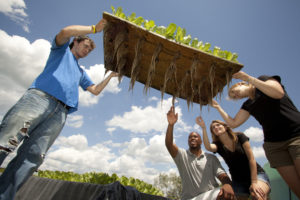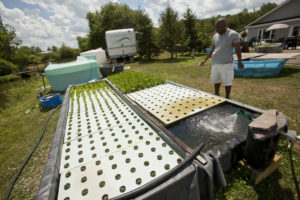
Environmental Scientist T.J. Eatmon helped students at Allegheny College create a system that can grow some of their cafeteria food.
What’s your favorite food? Do you know how its made or where it comes from?

What does fish poop have to do with the student cafeteria at Allegheny College? Or, in Environmental Scientist T.J. Eatmon’s words, “Can an indoor food production system that utilizes conservation methods while promoting healthy eating practices and community interactions be profitable and sustainable?”
T.J. Eatmon, a professor of environmental science at Allegheny College, and his students had the “aha!” moment that would lead to the tanks, pipes, pumps, and lights that build the answer to that question when they visited TREC, the Tom Ridge Environmental Center in Erie, Pennsylvania. That’s where they discovered aquaponics.
“Aquaponics” combines aquaculture (raising fish or other aquatic creatures) and hydroponics (growing plants in nutrient-rich water instead of soil). An aquaponic system’s tanks hold fish, whose waste is processed by bacteria in order to maintain a healthy environment for those fish and also for plants. At Allegheny, Eatmon’s students help keep this system running. They raise tilapia and lettuce, selling both to their college’s dining services and using the money they earn to buy the fish food and other supplies they need to keep this “closed-loop” system running.
People who run a closed-loop system use the waste products of making one thing to help make another. T.J. Eatmon, who studied chemical engineering at North Carolina State University and received his PhD from Southern University, also worked on a closed-loop system to help reduce the waste created by making cement. The production of cement contributes as much as five percent of the greenhouse gas emissions released across the world. Eatmon investigated using natural waste products, such as rice hulls, as a substitute for cement used in making concrete. This lowers the cost of making cement and reduces its impact on the environment.
As a child in Durham, North Carolina, T.J. found the clear rules of math and science attractive. “Math and science principles were appealing to me because I could recognize the patterns. It was just something that came naturally.” He learned about how he might use those skills as an engineer while participating in the Math and Science Education Network’s Pre-College Program. Through that program, which encourages members of minority groups and women to enter careers in math and science, T.J. was able to take pre-college classes at the University of North Carolina in Chapel Hill.

Now he helps his students in Meadville, Pennsylvania use the aquaponics system to do research about how to raise fish, build successful business models, measure the environmental impact of their system, and create opportunities for civic engagement. They help schools in Pennsylvania and other states build their own aquaponic systems. In order to solve environmental problems, says Eatmon, “We need biologists, economists, environmental scientists, and students with interests in many other areas to develop technology, business, and policy solutions across a broad spectrum of issues.”


